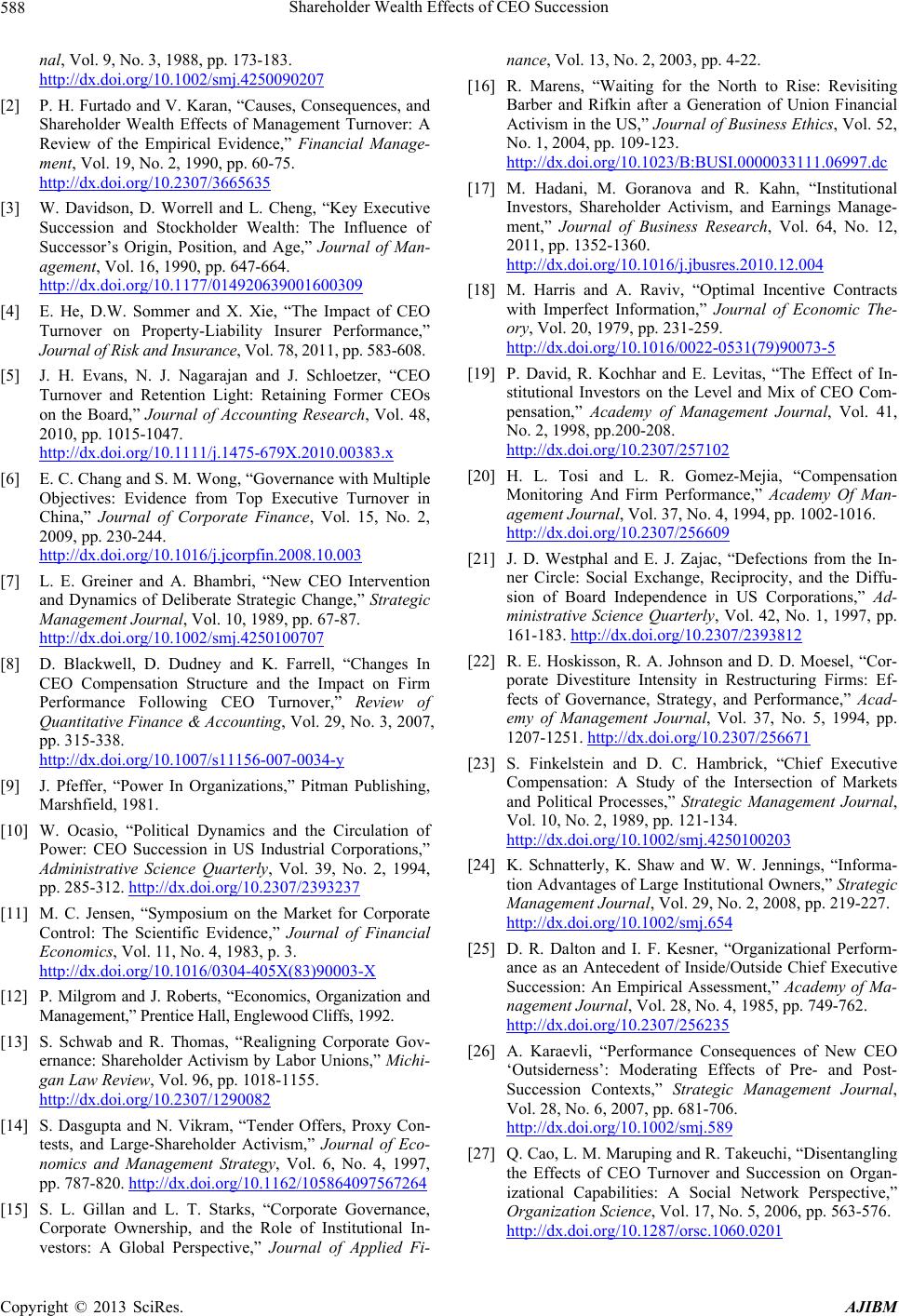
Shareholder Wealth Effects of CEO Succession
588
nal, Vol. 9, No. 3, 1988, pp. 173-183.
http://dx.doi.org/10.1002/smj.4250090207
[2] P. H. Furtado and V. Karan, “Causes, Consequences, and
Shareholder Wealth Effects of Management Turnover: A
Review of the Empirical Evidence,” Financial Manage-
ment, Vol. 19, No. 2, 1990, pp. 60-75.
http://dx.doi.org/10.2307/3665635
[3] W. Davidson, D. Worrell and L. Cheng, “Key Executive
Succession and Stockholder Wealth: The Influence of
Successor’s Origin, Position, and Age,” Journal of Man-
agement, Vol. 16, 1990, pp. 647-664.
http://dx.doi.org/10.1177/014920639001600309
[4] E. He, D.W. Sommer and X. Xie, “The Impact of CEO
Turnover on Property-Liability Insurer Performance,”
Journal of Risk and Insurance, Vol. 78, 2011, pp. 583-608.
[5] J. H. Evans, N. J. Nagarajan and J. Schloetzer, “CEO
Turnover and Retention Light: Retaining Former CEOs
on the Board,” Journal of Accounting Research, Vol. 48,
2010, pp. 1015-1047.
http://dx.doi.org/10.1111/j.1475-679X.2010.00383.x
[6] E. C. Chang and S. M. Wong, “Governance with Multiple
Objectives: Evidence from Top Executive Turnover in
China,” Journal of Corporate Finance, Vol. 15, No. 2,
2009, pp. 230-244.
http://dx.doi.org/10.1016/j.jcorpfin.2008.10.003
[7] L. E. Greiner and A. Bhambri, “New CEO Intervention
and Dynamics of Deliberate Strategic Change,” Strategic
Management Journal, Vol. 10, 1989, pp. 67-87.
http://dx.doi.org/10.1002/smj.4250100707
[8] D. Blackwell, D. Dudney and K. Farrell, “Changes In
CEO Compensation Structure and the Impact on Firm
Performance Following CEO Turnover,” Review of
Quantitative Finance & Accounting, Vol. 29, No. 3, 2007,
pp. 315-338.
http://dx.doi.org/10.1007/s11156-007-0034-y
[9] J. Pfeffer, “Power In Organizations,” Pitman Publishing,
Marshfield, 1981.
[10] W. Ocasio, “Political Dynamics and the Circulation of
Power: CEO Succession in US Industrial Corporations,”
Administrative Science Quarterly, Vol. 39, No. 2, 1994,
pp. 285-312. http://dx.doi.org/10.2307/2393237
[11] M. C. Jensen, “Symposium on the Market for Corporate
Control: The Scientific Evidence,” Journal of Financial
Economics, Vol. 11, No. 4, 1983, p. 3.
http://dx.doi.org/10.1016/0304-405X(83)90003-X
[12] P. Milgrom and J. Roberts, “Economics, Organization and
Management,” Prentice Hall, Englewood Cliffs, 1992.
[13] S. Schwab and R. Thomas, “Realigning Corporate Gov-
ernance: Shareholder Activism by Labor Unions,” Michi-
gan Law Review, Vol. 96, pp. 1018-1155.
http://dx.doi.org/10.2307/1290082
[14] S. Dasgupta and N. Vikram, “Tender Offers, Proxy Con-
tests, and Large-Shareholder Activism,” Journal of Eco-
nomics and Management Strategy, Vol. 6, No. 4, 1997,
pp. 787-820. http://dx.doi.org/10.1162/105864097567264
[15] S. L. Gillan and L. T. Starks, “Corporate Governance,
Corporate Ownership, and the Role of Institutional In-
vestors: A Global Perspective,” Journal of Applied Fi-
nance, Vol. 13, No. 2, 2003, pp. 4-22.
[16] R. Marens, “Waiting for the North to Rise: Revisiting
Barber and Rifkin after a Generation of Union Financial
Activism in the US,” Journal of Business Ethics, Vol. 52,
No. 1, 2004, pp. 109-123.
http://dx.doi.org/10.1023/B:BUSI.0000033111.06997.dc
[17] M. Hadani, M. Goranova and R. Kahn, “Institutional
Investors, Shareholder Activism, and Earnings Manage-
ment,” Journal of Business Research, Vol. 64, No. 12,
2011, pp. 1352-1360.
http://dx.doi.org/10.1016/j.jbusres.2010.12.004
[18] M. Harris and A. Raviv, “Optimal Incentive Contracts
with Imperfect Information,” Journal of Economic The-
ory, Vol. 20, 1979, pp. 231-259.
http://dx.doi.org/10.1016/0022-0531(79)90073-5
[19] P. David, R. Kochhar and E. Levitas, “The Effect of In-
stitutional Investors on the Level and Mix of CEO Com-
pensation,” Academy of Management Journal, Vol. 41,
No. 2, 1998, pp.200-208.
http://dx.doi.org/10.2307/257102
[20] H. L. Tosi and L. R. Gomez-Mejia, “Compensation
Monitoring And Firm Performance,” Academy Of Man-
agement Journal, Vol. 37, No. 4, 1994, pp. 1002-1016.
http://dx.doi.org/10.2307/256609
[21] J. D. Westphal and E. J. Zajac, “Defections from the In-
ner Circle: Social Exchange, Reciprocity, and the Diffu-
sion of Board Independence in US Corporations,” Ad-
ministrative Science Quarterly, Vol. 42, No. 1, 1997, pp.
161-183. http://dx.doi.org/10.2307/2393812
[22] R. E. Hoskisson, R. A. Johnson and D. D. Moesel, “Cor-
porate Divestiture Intensity in Restructuring Firms: Ef-
fects of Governance, Strategy, and Performance,” Acad-
emy of Management Journal, Vol. 37, No. 5, 1994, pp.
1207-1251. http://dx.doi.org/10.2307/256671
[23] S. Finkelstein and D. C. Hambrick, “Chief Executive
Compensation: A Study of the Intersection of Markets
and Political Processes,” Strategic Management Journal,
Vol. 10, No. 2, 1989, pp. 121-134.
http://dx.doi.org/10.1002/smj.4250100203
[24] K. Schnatterly, K. Shaw and W. W. Jennings, “Informa-
tion Advantages of Large Institutional Owners,” Strategic
Management Journal, Vol. 29, No. 2, 2008, pp. 219-227.
http://dx.doi.org/10.1002/smj.654
[25] D. R. Dalton and I. F. Kesner, “Organizational Perform-
ance as an Antecedent of Inside/Outside Chief Executive
Succession: An Empirical Assessment,” Academy of Ma-
nagement Journal, Vol. 28, No. 4, 1985, pp. 749-762.
http://dx.doi.org/10.2307/256235
[26] A. Karaevli, “Performance Consequences of New CEO
‘Outsiderness’: Moderating Effects of Pre- and Post-
Succession Contexts,” Strategic Management Journal,
Vol. 28, No. 6, 2007, pp. 681-706.
http://dx.doi.org/10.1002/smj.589
[27] Q. Cao, L. M. Maruping and R. Takeuchi, “Disentangling
the Effects of CEO Turnover and Succession on Organ-
izational Capabilities: A Social Network Perspective,”
Organization Science, Vol. 17, No. 5, 2006, pp. 563-576.
http://dx.doi.org/10.1287/orsc.1060.0201
Copyright © 2013 SciRes. AJIBM